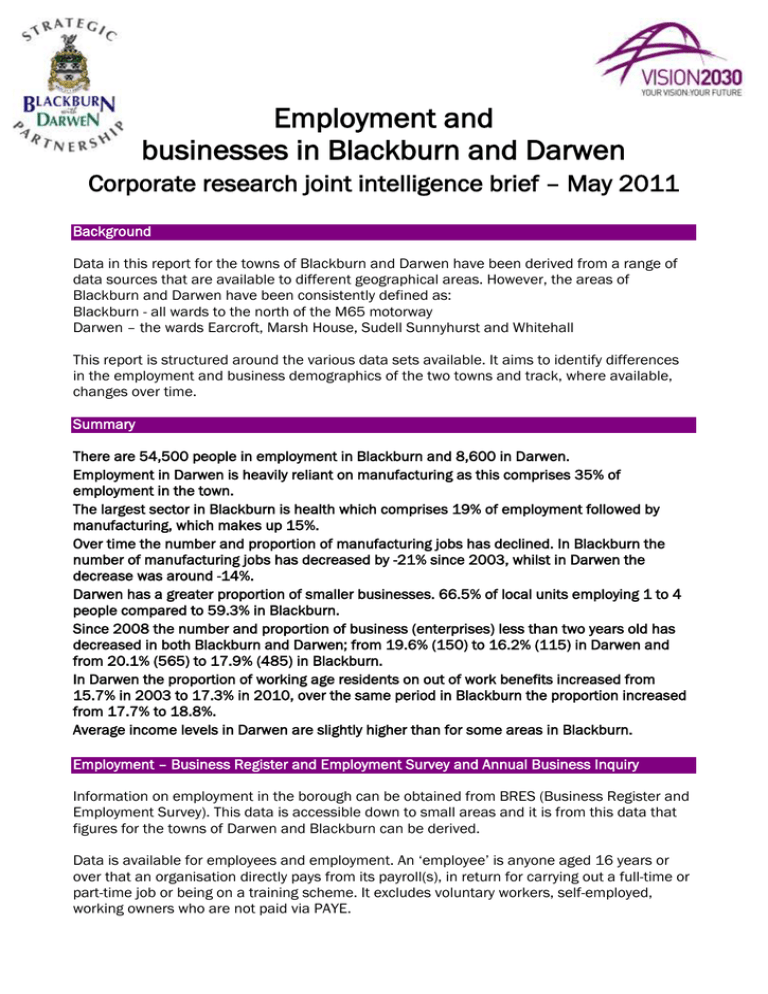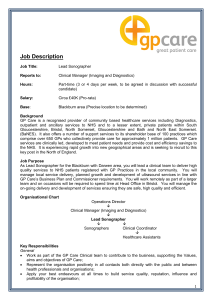Blackburn and Darwen Towns Employment Monitor
advertisement

Employment and businesses in Blackburn and Darwen Corporate research joint intelligence brief – May 2011 Background Data in this report for the towns of Blackburn and Darwen have been derived from a range of data sources that are available to different geographical areas. However, the areas of Blackburn and Darwen have been consistently defined as: Blackburn - all wards to the north of the M65 motorway Darwen – the wards Earcroft, Marsh House, Sudell Sunnyhurst and Whitehall This report is structured around the various data sets available. It aims to identify differences in the employment and business demographics of the two towns and track, where available, changes over time. Summary There are 54,500 people in employment in Blackburn and 8,600 in Darwen. Employment in Darwen is heavily reliant on manufacturing as this comprises 35% of employment in the town. The largest sector in Blackburn is health which comprises 19% of employment followed by manufacturing, which makes up 15%. Over time the number and proportion of manufacturing jobs has declined. In Blackburn the number of manufacturing jobs has decreased by -21% since 2003, whilst in Darwen the decrease was around -14%. Darwen has a greater proportion of smaller businesses. 66.5% of local units employing 1 to 4 people compared to 59.3% in Blackburn. Since 2008 the number and proportion of business (enterprises) less than two years old has decreased in both Blackburn and Darwen; from 19.6% (150) to 16.2% (115) in Darwen and from 20.1% (565) to 17.9% (485) in Blackburn. In Darwen the proportion of working age residents on out of work benefits increased from 15.7% in 2003 to 17.3% in 2010, over the same period in Blackburn the proportion increased from 17.7% to 18.8%. Average income levels in Darwen are slightly higher than for some areas in Blackburn. Employment – Business Register and Employment Survey and Annual Business Inquiry Information on employment in the borough can be obtained from BRES (Business Register and Employment Survey). This data is accessible down to small areas and it is from this data that figures for the towns of Darwen and Blackburn can be derived. Data is available for employees and employment. An ‘employee’ is anyone aged 16 years or over that an organisation directly pays from its payroll(s), in return for carrying out a full-time or part-time job or being on a training scheme. It excludes voluntary workers, self-employed, working owners who are not paid via PAYE. The ‘employment’ figures are calculated as the total number of employees and working proprietors. Working Proprietors are sole traders, sole proprietors, partners and directors. This does not apply to registered charities. The figures in the flowing section relate to ‘employment’ data. All BRES and ABI data in this report excludes farm agriculture (SIC subclass 01000). In total there were 54,500 people in employment in Blackburn and 8,600 in Darwen. Numerically, there are far greater levels of employment in each sector in Blackburn compared to Darwen. Darwen’s employment base is heavily reliant on the manufacturing sector as 36% of people in employment are employed in this sector. The next largest sectors in Darwen town are ‘health’ (9%), ‘information and communication’ (8%), ‘retail’ (8%) and ‘education’ (7%). Compared to Blackburn, Darwen has a greater proportion of people employed in ‘information and communications’ and the ‘accommodation and food services’. (See appendix for classification details). Just under a fifth (19%) of employment in Blackburn is in the ‘health’ sector, this is the largest sector in the town. ‘Manufacturing’ (15%), ‘education’ (10%) and ‘retail’ (9%) are the next largest sectors. Employment in Blackburn and Darwen – number of people in employment in each sector, 2009 Darwen A rts, entertainment, recreatio n & o ther services (R,S,T and U) Blackburn Health (Q) Educatio n (P ) P ublic administratio n & defence (O) B usiness administratio n & suppo rt services (N) P ro fessio nal, scientific & technical (M ) P ro perty (L) Financial & insurance (K) Info rmatio n & co mmunicatio n (J) A cco mmo datio n & fo o d services (I) Transpo rt & sto rage (inc po stal) (H) Retail (P art G) Who lesale (P art G) M o to r trades (P art G) Co nstructio n (F) M anufacturing (C) A griculture, fo restry, fishing, mining, quarrying & utilities (A , B ,D and E) 0 2,000 4,000 6,000 8,000 10,000 12,000 Number Employment in Blackburn and Darwen - proportion of employment in each sector, 2009 Darwen Arts, entertainment, recreation & other services (R,S,T and U) Blackburn Health (Q) Education (P) Public administration & defence (O) Business administration & support services (N) Professional, scientific & technical (M) Property (L) Financial & insurance (K) Information & communication (J) Accommodation & food services (I) Transport & storage (inc postal) (H) Retail (Part G) Wholesale (Part G) Motor trades (Part G) Construction (F) Manufacturing (C) Agriculture, forestry, fishing, mining, quarrying & utilities (A, B,D and E) 0 5 10 15 20 25 Percentage 30 35 40 Assessing change over time is more difficult due to changes in classification systems and the methodology used to collate data. From 2003 to 2008 classifications of industry are available using the 2003 Standard Industrial Classification (SIC). From 2007, the 2007 SIC was introduced and analyses of the Annual Business Inquiry survey are available for 2007 and 2008 using the 2007 SIC. But please also note that a methodology change was made to the Annual Business Survey in 2006 which means this data set is not continually produced using the same methodology. From 2008 the Annual Business Inquiry survey was replaced by the Business Register and Employment Survey (BRES). BRES data is available for 2008 and 2009. For the purpose of identifying trends over time the 2003 to 2008 Annual Business Inquiry data using the 2003 SIC has been used (but please be aware of the discontinuity from 2006 onwards). The data for Darwen reflects the high number and proportion of jobs in the area that are in the manufacturing sector. Between 2003 and 2008 the proportion of jobs in this sector has decreased, although the 2009 data from the BRES suggests that between 2008 and 2009 the proportion of jobs in the manufacturing sector has remained relatively stable at around 35%. Over this time the number of jobs in manufacturing decreased by 14%. Interestingly, the number and proportion of employees in the ‘banking, finance and insurance’ sector has increased in Darwen, by 140% from 600 jobs in 2003 to 1,500 jobs in 2008 (this sector included real estate). However, due to the changes in the SIC and ABI methodology it is difficult to identify whether this is a continuing trend and how much is influenced by the methodology change, similar classifications in the 2007 SIC suggest that this increase is not continuing. For Blackburn the trends of a decline in manufacturing and increase in the banking, finance and insurance sectors have shown similar trends to Darwen. The number of employees in manufacturing has decreased by 21%, a greater proportion than Darwen. Whilst the banking finance and insurance sector increased by around 20%. Number of employees per sector using the 2003 SIC for Blackburn, 2003 to 2008 Manufacturing (SIC D) 20,000 18,000 Construction (SIC F) 16,000 Distribution, hotels and restaurants (SIC G,H) 14,000 Number 12,000 Transport and communications (SIC I) 10,000 8,000 Banking, finance and insurance, etc (SIC J,K) 6,000 Public administration,education & health (SIC L,M,N) 4,000 2,000 Agriculture and fishing, energy and water and other (SIC A,B,C,E,O,P,Q) 0 2003 2004 2005 2006 2007 2008 * please note methodology change in 2006 Percentage of employees per sector using the 2003 SIC for Blackburn, 2003 to 2008 40.0 Manufacturing (SIC D) 35.0 Construction (SIC F) 30.0 Distribution, hotels and restaurants (SIC G,H) Percentage 25.0 Transport and communications (SIC I) 20.0 Banking, finance and insurance, etc (SIC J,K) 15.0 Public administration,education & health (SIC L,M,N) 10.0 5.0 Agriculture and fishing, energy and water and other (SIC A,B,C,E,O,P,Q) 0.0 2003 2004 2005 2006 * please note methodology change in 2006 2007 2008 Number of employees per sector using the 2003 SIC for Darwen, 2003 to 2008 4,000 Manufacturing (SIC D) 3,500 Construction (SIC F) 3,000 Distribution, hotels and restaurants (SIC G,H) Number 2,500 Transport and communications (SIC I) 2,000 Banking, finance and insurance, etc (SIC J,K) 1,500 Public administration,education & health (SIC L,M,N) 1,000 500 Agriculture and fishing, energy and water and other (SIC A,B,C,E,O,P,Q) 0 2003 2004 2005 2006 2007 2008 * please note methodology change in 2006 Percentage of employees per sector using the 2003 SIC for Darwen, 2003 to 2008 Manufacturing (SIC D) 45.0 40.0 Construction (SIC F) 35.0 Distribution, hotels and restaurants (SIC G,H) Percentage 30.0 25.0 Transport and communications (SIC I) 20.0 Banking, finance and insurance, etc (SIC J,K) 15.0 Public administration,education & health (SIC L,M,N) 10.0 5.0 Agriculture and fishing, energy and water and other (SIC A,B,C,E,O,P,Q) 0.0 2003 2004 2005 2006 2007 2008 * please note methodology change in 2006 The Annual Business Inquiry also allows an analysis of the workplace by local units (see IDBR section for a description of a ‘local unit’). The data highlights that Darwen has a similar proportion of local units in the manufacturing sector, compared to Blackburn. The ten percent of local units in this sector in Darwen provide around 35% of employment in the town. Whilst in Blackburn, just under ten percent of local units in this sector provide around 15% of employment. The proportion of workplaces in each industrial classification in the two towns differs; in for example that Darwen has a greater proportion of ‘accommodation and food place’ (classification I) workplaces in the town compared to Blackburn. Blackburn has a greater proportion of workplaces in the ‘pubic administration and other’ category (classification O and R – U). An alternative dataset, the BetaModel, presents enterprise / business information, this data is presented later in the report. Employers Inter Departmental Business Register The Office for National Statistics holds a data set called the Inter Departmental Business Register (IDBR). Statistics from this data source are produced down to middle layer super output areas (msoa). The IDBR is made up of businesses registered to pay VAT and PAYE businesses. The figures produced differ to those produced by the Beta Model (see later), but also highlight that Darwen has a greater proportion of small businesses. These figures present data on ‘local units’. A local unit can be described roughly as a workplace (shop, factory etc), for example a company many have more than one shop or local unit in a town, each will be a local unit. Number and percentage of employees in ‘local units’ for Blackburn and Darwen, March 2008 to March 2010 March 2010 March 2009 March 2008 Blackburn Darwen Blackburn Darwen Blackburn Darwen All VAT and/or PAYE Based Local Units 3645 865 3755 915 3745 915 All 0 to 4 Persons Employed Number % 2160 59.3 575 66.5 2215 59.0 615 67.2 2235 59.7 615 67.2 All 5 to 9 Persons Employed Number % 600 16.5 130 15.0 650 17.3 145 15.8 615 16.4 155 16.9 All 10 to 19 Persons Employed Number % 420 11.5 80 9.2 385 10.3 80 8.7 420 11.2 75 8.2 All 20 or More Persons Employed Number % 465 12.8 80 9.2 505 13.4 75 8.2 475 12.7 70 7.7 The number and proportion of businesses that were less than two years old have decreased in both Blackburn and Darwen. These figures are based on ‘enterprises’. An enterprise is essentially a business and is located at the main operating site or head office. Larger enterprises may have more than one ‘local unit’ but will only be recorded at the location of the head office. Number and percentage of enterprises in Blackburn and Darwen by age, March 2008 to March 2010 March 2010 March 2009 March 2008 Blackburn Darwen Blackburn Darwen Blackburn Darwen All VAT and/or PAYE Based Enterprises 2710 710 2810 745 2815 765 Less than 2 Years Old Number % 485 17.9 115 16.2 525 18.7 135 18.1 565 20.1 150 19.6 2 to 3 Years Old Number % 430 15.9 100 14.1 475 16.9 100 13.4 465 16.5 110 14.4 4 to 9 Years Old Number % 750 27.7 185 26.1 745 26.5 205 27.5 730 25.9 195 25.5 10 or More Years Old Number % 1045 38.6 310 43.7 1065 37.9 305 40.9 1055 37.5 310 40.5 Although only available for 2008 and 2009, data from the IDBR is also available that classifies local units as either ‘public’ or ‘private’. However, these statistics only classify the business and do not capture the proportion of employees in each business. These figures highlight that of the local units in Blackburn 8.3% were classified as public, with 4.9% in Darwen. Employers – Beta Model In addition to the official Office for National Statistics data, information about businesses (rather than employees) in the borough was available from the Beta Model Ltd. Unfortunately the Beta Model has ceased operation and data is no longer available, but prior to this data for a number of years was downloaded and is held by the Corporate Research team. Within Blackburn the Beta Model recorded 4,415 businesses compared to 1,168 in Darwen. The two sectors that Blackburn had a greater proportion of businesses in compared to Darwen were the ‘wholesale and retail trade; repair of motor vehicle’ and ‘real estate, renting and business activities’ sectors. Darwen saw a greater proportion of its businesses in the ‘construction’ and ‘hotels and restaurants’ sectors. Three quarters (74.1%) of businesses in Darwen employed 1 to 5 people, compared to just over two fifths (68.4%) in Blackburn. Business type in Blackburn and Darwen, January 2010 (BetaModel) Who lesale A nd Retail Trade; Repair Of M o to r Vehicles Transpo rt, Sto rage A nd Co mmunicatio n Real Estate, Renting A nd B usiness A ctivities P ublic A dministratio n A nd Defence; Co mpulso ry P rivate Ho useho lds With Emplo yed P erso ns Other Co mmunity, So cial & P erso nal Service A c M anufacturing Ho tels A nd Restaurants Health A nd So cial Wo rk Fishing Financial Intermediatio n Extra - Territo rial Organisatio ns A nd B o dies Electricity, Gas A nd Water Supply Educatio n Co nstructio n Darwen A griculture, Hunting A nd Fo restry 0 5 10 15 Percentage Blackburn 20 25 Total unknown 250+ 101 to 250 51 to 100 21 to 50 11 to 20 1 to 5 Number of employees Darwen Number Darwen % Blackburn Number Blackburn % 6 to 10 Business size in Blackburn and Darwen, January 2010 (BetaModel) 866 74.1 143 12.2 86 7.4 52 4.5 11 0.9 9 0.8 0 0.0 1 0.1 1168 100 3022 68.4 579 13.1 367 8.3 270 6.1 85 1.9 45 1.0 26 0.6 21 0.5 4415 100 Business size in Blackburn and Darwen, January 2010 (BetaModel) 1 to 5 6 to 10 11 to 20 21 to 50 51 to 100 Darwen 101 to 250 250+ unknown Blackburn Benefits data Over the period November 2003 to November 2010 the number and proportion of benefit claimants in the Darwen area has increased. In 2003 18.1% of people aged 16 to 64 were in receipt of benefits, by 2010 this had increased to 20.2%. Focusing on ‘out of work benefits’1, the number in receipt also increased from 15.7% in 2003 to 17.3% in 2010. This increase appears driven by increased numbers of people claiming JSA and ESA/IB. The rate of claimants in Blackburn is greater than for Darwen. In 2003 20.8% of residents aged 16 to 64 in Blackburn were claiming benefit, this had increased to 22.8% in 2010. More specifically out of work benefit claimants increased over this time period from 17.7% to 18.8%. Whilst a greater proportion of residents were claiming benefits in Blackburn, the rate of increase in out of benefit claimants was greater in Darwen compared to Blackburn. There was Out of work benefits are: Job seekers allowance, ESA and Incapacity benefits, lone parents and others in receipt of income related benefits. 1 an 8.1% increase in the number of claimants in Darwen compared to Blackburn, which saw a 6.2% increase. Number and percentage of benefit claimants in Darwen, November 2003 to November 2010 total claimants statistical group - job seekers statistical group - ESA and incapacity benefits statistical group - lone parents statistical group - carers statistical group - others on income related benefits statistical group - disabled statistical group - bereaved statistical group - unknown out-of-work benefits 2003 Number 3,230 325 % 18.1 1.8 2010 Number 3,520 575 % 20.2 3.3 Difference Number 290 250 % point 2.1 1.5 1,905 10.7 1,960 11.2 55 0.5 485 2.7 365 2.1 -120 -0.6 190 1.1 220 1.3 30 0.2 75 0.4 115 0.7 40 0.3 170 80 0 2,790 1.0 0.4 0.0 15.7 250 35 0 3,015 1.4 0.2 0.0 17.3 80 -45 0 225 0.4 -0.2 0.0 1.6 Number and percentage of benefit claimants in Blackburn, November 2003 to November 2010 total claimants statistical group - job seekers statistical group - ESA and incapacity benefits statistical group - lone parents statistical group - carers statistical group - others on income related benefits statistical group - disabled statistical group - bereaved statistical group - unknown out-of-work benefits 2003 Number 13,985 1,455 % 20.8 2.2 2010 Number 15,315 2,790 % 22.8 4.2 Difference Number 1,330 1,335 % point 2.0 2.0 7,920 11.8 7,780 11.6 -140 -0.2 2,130 3.2 1,575 2.3 -555 -0.9 1,095 1.6 1,485 2.2 390 0.6 420 0.6 460 0.7 40 0.1 680 285 0 11,925 1.0 0.4 0.0 17.7 1,080 145 0 12,605 1.6 0.2 0.0 18.8 400 -140 0 680 0.6 -0.2 0.0 1.1 Income Model based estimates of weekly household income are available from the Office for National Statistics at middle super output area level (msoa). These msoas can be aggregated to form the areas of Blackburn and Darwen. This data is calculated for the April 2007/March 2008 period. The Blackburn area is made up of 13 msoas and Darwen four. Income will include wages but also income through benefits and savings or investments. Of the msoas that make up Blackburn, the median average weekly income was £480, whilst in Darwen this was £515. Within Darwen all msoas saw similar incomes, ranging from £510 to £590. However for Blackburn the range was much wider with the lowest average income £380 and the highest £730. Average weekly household total income by middle super output areas, for Blackburn and Darwen, 2007/08 Average weekly household total income by middle super output areas, for Blackburn and Darwen, 2007/08 Msoa code BwD 1 BwD 2 BwD 3 BwD 4 BwD 5 BwD 6 BwD 7 BwD 8 BwD 9 BwD 10 BwD 11 BwD 12 BwD 13 BwD 14 BwD 15 BwD 16 BwD 17 BwD 18 Town Blackburn Blackburn Blackburn Blackburn Blackburn Blackburn Blackburn Blackburn Blackburn Blackburn Blackburn Blackburn Blackburn Darwen Darwen Darwen Darwen Rural Average Weekly Household Total Income Estimate (£) 570 690 430 450 440 390 380 450 480 700 550 530 730 510 510 520 590 840 Average Weekly Household Net Income Estimate (£) 460 550 350 370 380 320 320 370 390 560 430 430 570 420 400 420 490 670 The most affluent msoa within the borough falls outside the areas of Blackburn and Darwen and is the rural area to the south of the borough which saw an average household weekly income of £840. Copyright, sources and further information For further information please contact: Elise Carroll Research and Intelligence Advisor Corporate Research Joint Intelligence 3rd Floor Old Town Hall elise.carroll@blackburn.gov.uk 01254 585693 Contains public sector information licensed under the Open Government Licence v1.0 Sources: Business Register and Employment Survey Annual Business Survey Inter Departmental Business Register Department for Work and Pensions benefit claimants https://www.nomisweb.co.uk/Default.asp Model based household income estimates http://neighbourhood.statistics.gov.uk/dissemination Beta Model – data no longer available http://www.betamodel.com/mini-sites/lep-chart/the-beta-model.pdf Appendix – Standard Industrial Classification 2007 A AGRICULTURE, FORESTRY AND FISHING 01 B C 02 03 Crop and animal production, hunting and related service activities Forestry and logging Fishing and aquaculture 05 06 07 08 09 Mining of coal and lignite Extraction of crude petroleum and natural gas Mining of metal ores Other mining and quarrying Mining support service activities 10 11 12 13 14 15 16 30 31 32 33 Manufacture of food products Manufacture of beverages Manufacture of tobacco products Manufacture of textiles Manufacture of wearing apparel Manufacture of leather and related products Manufacture of wood and of products of wood and cork, except furniture; manufacture of articles of straw and plaiting materials Manufacture of paper and paper products Printing and reproduction of recorded media Manufacture of coke and refined petroleum products Manufacture of chemicals and chemical products Manufacture of basic pharmaceutical products and pharmaceutical preparations Manufacture of rubber and plastic products Manufacture of other non-metallic mineral products Manufacture of basic metals Manufacture of fabricated metal products, except machinery and equipment Manufacture of computer, electronic and optical products Manufacture of electrical equipment Manufacture of machinery and equipment n.e.c. Manufacture of motor vehicles, trailers and semitrailers Manufacture of other transport equipment Manufacture of furniture Other manufacturing Repair and installation of machinery and equipment 35 Electricity, gas, steam and air conditioning supply 36 37 38 39 Water collection, treatment and supply Sewerage Waste collection, treatment and disposal activities; materials recovery Remediation activities and other waste management services. This division includes the provision of remediation services, i.e. the cleanup of contaminated buildings and sites, soil, surface or ground water. 41 42 43 Construction of buildings Civil engineering Specialised construction activities 45 Wholesale and retail trade and repair of motor MINING AND QUARRYING MANUFACTURING 17 18 19 20 21 22 23 24 25 26 27 28 29 D E F G ELECTRICITY, GAS, STEAM AND AIR CONDITIONING SUPPLY WATER SUPPLY; SEWERAGE, WASTE MANAGEMENT AND REMEDIATION ACTIVITIES CONSTRUCTION WHOLESALE AND RETAIL TRADE; REPAIR OF MOTOR VEHICLES AND MOTORCYCLES 46 47 H I J TRANSPORTATION AND STORAGE 49 50 51 52 53 Land transport and transport via pipelines Water transport Air transport Warehousing and support activities for transportation Postal and courier activities 55 56 Accommodation Food and beverage service activities 58 59 Publishing activities Motion picture, video and television programme production, sound recording and music publishing activities Programming and broadcasting activities Telecommunications Computer programming, consultancy and related activities Information service activities ACCOMMODATION AND FOOD SERVICE ACTIVITIES INFORMATION AND COMMUNICATION 60 61 62 63 K FINANCIAL AND INSURANCE ACTIVITIES 64 65 66 L M 68 Real estate activities 69 70 Legal and accounting activities Activities of head offices; management consultancy activities Architectural and engineering activities; technical testing and analysis Scientific research and development Advertising and market research Other professional, scientific and technical activities Veterinary activities PROFESSIONAL, SCIENTIFIC AND TECHNICAL ACTIVITIES 72 73 74 75 ADMINISTRATIVE AND SUPPORT SERVICE ACTIVITIES 77 78 79 80 81 82 O Financial service activities, except insurance and pension funding Insurance, reinsurance and pension funding, except compulsory social security Activities auxiliary to financial services and insurance activities REAL ESTATE ACTIVITIES 71 N vehicles and motorcycles Wholesale trade, except of motor vehicles and motorcycles Retail trade, except of motor vehicles and motorcycles Rental and leasing activities Employment activities Travel agency, tour operator and other reservation service and related activities Security and investigation activities Services to buildings and landscape activities Office administrative, office support and other business support activities PUBLIC ADMINISTRATION AND DEFENCE; COMPULSORY SOCIAL SECURITY 84 84.1 84.11 Public administration and defence; compulsory social security Administration of the State and the economic and social policy of the community General public administration activities 84.12 84.13 84.2 84.21 84.22 84.23 84.24 84.25 84.3 84.30 P EDUCATION 85 Q 92 93 95.1 95.2 Activities of membership organisations Activities of business, employers and professional membership organisations Activities of trade unions Activities of other membership organisations Repair of computers and personal and household goods Repair of computers and communication equipment Repair of personal and household goods 96 96.0 Other personal service activities Other personal service activities 94.2 94.9 95 ACTIVITIES OF HOUSEHOLDS AS EMPLOYERS; UNDIFFERENTIATED GOODS-AND SERVICESPRODUCING ACTIVITIES OF HOUSEHOLDS FOR OWN USE 97 98 U Creative, arts and entertainment activities Libraries, archives, museums and other cultural activities Gambling and betting activities Sports activities and amusement and recreation activities OTHER SERVICE ACTIVITIES 94 94.1 T Human health activities Hospital activities Medical and dental practice activities Other human health activities Residential care activities Social work activities without accommodation ARTS, ENTERTAINMENT AND RECREATION 90 91 S Education HUMAN HEALTH AND SOCIAL WORK ACTIVITIES 86 86.1 86.2 86.9 87 88 R Regulation of the activities of providing health care, education, cultural services and other social services, excluding social security Regulation of and contribution to more efficient operation of businesses Provision of services to the community as a whole Foreign affairs Defence activities Justice and judicial activities Public order and safety activities Fire service activities Compulsory social security activities Compulsory social security activities Activities of households as employers of domestic personnel Undifferentiated goods- and services-producing activities of private households for own use ACTIVITIES OF EXTRATERRITORIAL ORGANISATIONS AND BODIES 99 Activities of extraterritorial organisations and bodies



